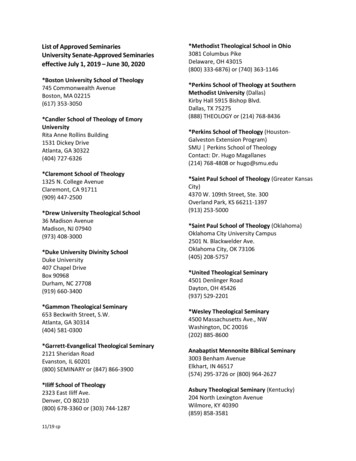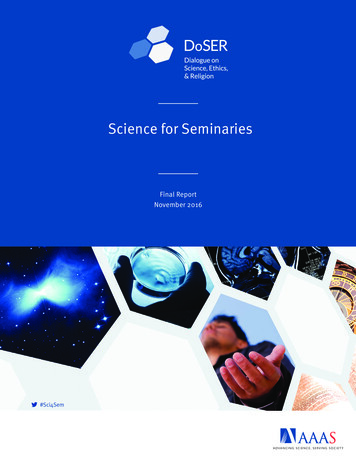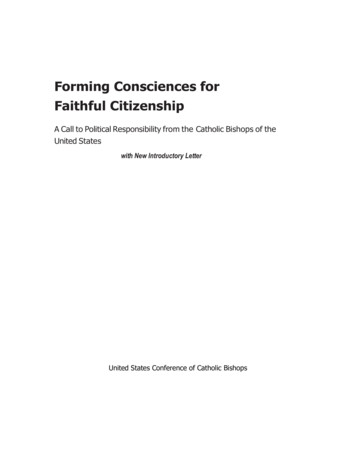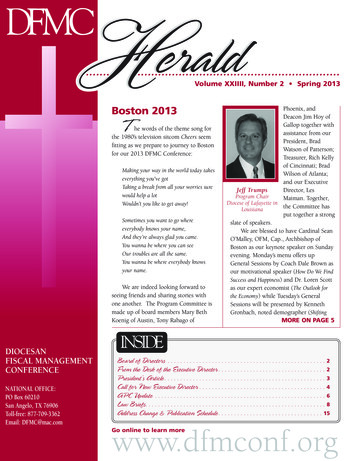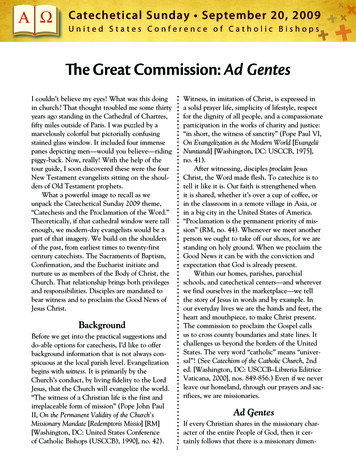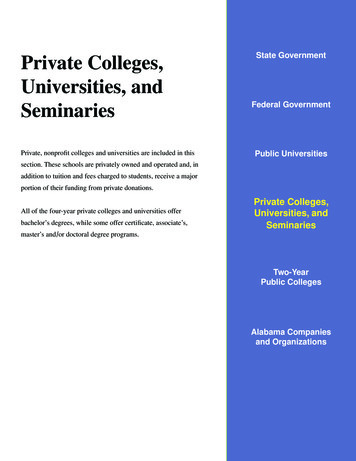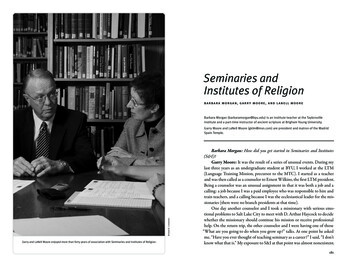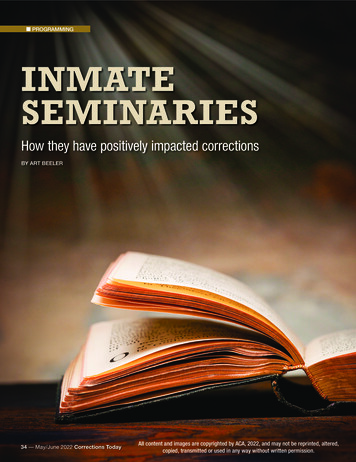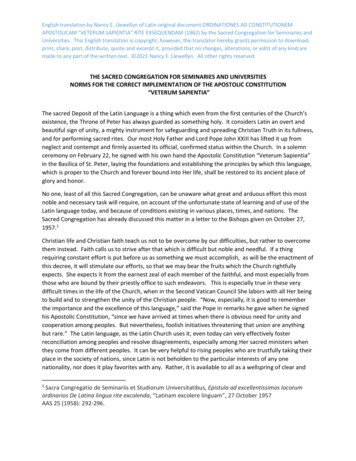
Transcription
Center for Applied Research in the ApostolateGeorgetown UniversityWashington, DCEngaging Science in SeminariesA Report to the USCCB Secretariat of Clergy,Consecrated Life and VocationsApril 2017Mary L. Gautier, Ph.D.Bibiana M. Ngundo LSOSF, Ph.D.Michal J. Kramarek, Ph.D.
Table of ContentsExecutive Summary . 1Major Findings . 2Introduction . 4Organization of This Report . 4Part I: Responding U.S. Institutions . 6Enrollment. 6Seminary Rectors . 7Director of Spiritual Life . 8Seminary Faculty . 10Faculty Background in Science . 11Faculty Research or Writing on the Intersection of Religion and Science . 12Topics or Issues for Current Research/Writing . 12Scientific Topics Included in Seminary Program . 14Laudato Si . 15Course(s) That Explore “Laudato Si” . 16Integration of Science and Religion . 17Symposia on the Topic of Science and Religion . 20Symposium Titles . 20Workshop(s) on the Topic of Science and Religion . 22Workshop Titles . 22Guest Lecturer . 24Background of Guest Lecturer(s). 24Disagreement or Controversies Arising from Symposia or Workshops . 27Preparing Seminarians to Evangelize . 28Other Topics or Issues on Science and Religion That Are Important to Good Preparation . 33Challenges to Preparing Seminarians to Evangelizein a World Shaped by Science and Technology . 36Other Thoughts Regarding the Topic of Science and Religion in Catholic Seminaries . 40Part II: Responding Institutions outside the United States . 43Appendix: Questionnaires with Response Frequencies . 48
Center for Applied Research in the ApostolateGeorgetown UniversityWashington, DCEngaging Science in SeminariesA Report for the USCCB Secretariat of Clergy,Consecrated Life and VocationsExecutive SummaryIn summer 2016, the John Templeton Foundation commissioned CARA to study theintersection of faith and science in the seminaries of six English-speaking nations (United States,Canada, Great Britain, Ireland, South Africa, and Australia). The USCCB Secretariat of Clergy,Consecrated Life and Vocations expressed interest in learning from seminary rectors theirassessment of how science and theology are integrated in the seminary curriculum in light of therelevant PPF norms, and in particular their preparation of seminarians as pastoral leaders who areable to address critical questions of science and theology.CARA contacted seminary rectors at 40 theologates and 28 college level seminaries thatoperate under the Program of Priestly Formation of the U.S. Conference of Catholic Bishops torequest their participation in a survey about how their seminaries form seminarians at theintersection of science and religion. CARA also contacted seminary rectors, via email, at 12seminaries in Australia, 11 in Canada, five in South Africa, four in Great Britain, and two inIreland with the same request.The purpose of the survey is to inform the John Templeton Foundation and to assist theUSCCB Committee on Clergy, Consecrated Life and Vocations in understanding more clearlyhow science and theology are taught within the seminary curriculum and integrated intoseminary formation.1
Major FindingsAcademic Faculty and Scientific Topics Theologate rectors report an average of ten full-time clergy faculty and seven full-timelay faculty employed by the seminary. College rectors report an average of four full-timeclergy faculty and four full-time lay faculty. Both theologates and college seminariesaverage one clergy faculty and one lay faculty with a background in science. Overall, two in three responding rectors report that some faculty members currentlyconduct research or writing on the intersection of religion and science (e.g., in ontology,bioethics). Theologates are more likely than college seminaries to have a facultymember currently researching or writing in this area. Some of the topics or issues onwhich faculty members currently research include bioethics, evolution and theology,faith and reason, integrated approaches to the human person, medical ethics, and musicand neuroscience. More than half of responding seminary rectors identify six of eight scientific topics thatare included in their seminary program. Theologate rectors are more likely than collegerectors to say they include ontology, cosmology, epistemology, historical theology,applied ethics in science, and bioethics in their program.Overall, almost six in ten rectors report that Pope Francis’ encyclical “Laudato Si” isincluded in their current seminary curriculum. Theologate rectors are more likely thancollege seminary rectors to indicate that the encyclical is included in their currentcurriculum.Symposia, Workshops, Guest Lectures on Science and Religion One in three rectors report that in the past two years their seminary has held asymposium that explicitly addressed some aspect of the topic of science and religion.College seminaries are slightly more likely than theologates to have held such asymposium in the past two years. One in five rectors say that their seminary has held a workshop that explicitly addressedan aspect of the topic of science and religion in the past two years. Theologates are alittle more likely than college seminaries to have held a workshop. Six in ten seminary rectors report that their seminary has invited a guest lecturer whoexplicitly addressed an aspect of the topic of science and religion in the past two years.Theologate rectors are a little more likely than college rectors to have invited a guestlecturer.2
Among seminaries who have had a guest lecturer to address some aspect of the topic ofscience and religion, rectors were more likely to report that the guest lecturer theyinvited to speak on the topic of science and religion was a scientist/scholar/academicianthan a religious/Church leader.Preparing Seminarians to Evangelize Overall, seminary rectors are more likely to say that their seminary uses optionalcourses, rather than the core curriculum, to prepare their seminarians to evangelize in ascientific and technological world by engaging the bigger question of science. Seven inten use optional courses, compared to six in ten who use their core curriculum and lessthan half who use extracurricular activities for this purpose. Theologate rectors are more likely than college rectors to report using optional coursesto prepare seminarians to evangelize in a scientific and technological world engaging thebigger question of science. College and theologate rectors are equally likely to reportusing their core curriculum or extracurricular means to prepare their seminarians toevangelize. When asked how important seminarians’ understanding of various scientific topics for istheir preparation to evangelize in a scientific and technological world, rectors ranked theunderstanding of human sexuality and euthanasia of highest importance. Rectors rankedunderstanding of stem cell research, genetic engineering, Darwinism, scientific method,and Internet technologies as nearly as important. Theologate rectors are more likely than college seminary rectors to report that it is “veryimportant” for seminarians to understand euthanasia. By contrast, college rectors aremore likely than theologate rectors to rank Internet technologies and scientific method as“very important” for their preparation to evangelize in a scientific and technologicalworld.Challenges College rectors report challenges in preparing seminarians to evangelize, such as “aproper understanding of science itself, including its presuppositions, methods,contributions, limitations and place in our society, as well as both its connection to andindependence from faith.” Another described the challenge of “keeping updated withrapid and complicated issues on an ongoing basis.” Theologate rectors also report challenges such as “assisting seminarians to develop arightly grounded faith in the Gospel and Church in a period of rapid social change anddiscovery. To properly train faculty and find the extended time needed for seminariansto obtain a thorough philosophical education within the Church's patrimony which hasthe ability to unify the Church's theology with legitimate developments in science andtechnology, in one vision, while properly keeping the two sciences distinct.”3
IntroductionIn summer 2016, the John Templeton Foundation commissioned CARA to study theintersection of faith and science in the seminaries of six English-speaking nations (United States,Canada, Great Britain, Ireland, South Africa, and Australia). The USCCB Secretariat of Clergy,Consecrated Life and Vocations expressed interest in learning from seminary rectors theirassessment of how science and theology are integrated in the seminary curriculum in light of therelevant PPF norms, and in particular their preparation of seminarians as pastoral leaders who areable to address critical questions of science and theology.The purpose of the study is to inform the John Templeton Foundation and to assist theUSCCB Committee on Clergy, Consecrated Life and Vocations in understanding more clearlyhow science and theology are taught within the seminary curriculum and integrated intoseminary formation.CARA developed two questionnaires – one for college rectors and one for theologaterectors – in collaboration with a representative from the John Templeton Foundation and theUSCCB Secretariat for Clergy, Consecrated Life and Vocations. CARA distributed thequestionnaires to all seminary rectors from its contact list of 28 college seminaries and 40theologates in the CARA Catholic Ministry Formation Directory and via email to all seminaryrectors in five English-speaking countries: 12 seminaries in Australia, 11 in Canada, five inSouth Africa, four in Great Britain, and two in Ireland. CARA conducted follow-up with nonrespondents by e-mail, fax, and phone to achieve the highest possible response rate.By the cut-off date of February 15, 2017, CARA received completed surveys from 32U.S. theologates and 19 U.S. college seminaries, for a response rate of 78 percent among U.S.theologates and 68 percent among U.S. college seminaries. In addition, two theologates fromAustralia, Canada, and one each from South Africa and Ireland completed the survey, as did onecollege seminary in South Africa. In total there were seven respondents from these seminaries.Because these surveys were distributed to all eligible seminaries rather than to arepresentative sample of seminaries, measures of statistical significance are inappropriate.Statistical significance is based on the premise that a relatively small proportion of cases havebeen randomly sampled from a population. Due to the relatively high response to the surveyamong U.S. seminaries, the results presented in this report can be interpreted as representing allU.S. seminaries, not a sample.Organization of This ReportPart I of the report examines the intersection of science and religion in U.S. college andtheologate level seminaries. Results for the other English-speaking seminaries who respondedare summarized in Part II of this report.The questionnaire consisted of 15 closed-ended questions concerning the ways thatseminaries engage science in the curriculum and in formation as well as four open-endedquestions regarding course examples, other topics, challenges in preparing seminarians, and4
other thoughts regarding the topic of science and religion in Catholic seminaries. Thequestionnaire for theologates and for colleges was identical but it is likely that seminaryformation in this area differs significantly between these two levels of seminary formation.Therefore, the report compares the findings for each of these levels separately.Part II of the report presents a brief summary of the findings from the seven respondingEnglish-speaking seminaries in other parts of the world.A copy of the original questionnaires with the percentage responses from U.S.theologates and U.S. college seminaries for each closed-ended item, calculated out of 100percent, can be found in the Appendix. The percentage of non-respondents to each item,calculated separately out of 100 percent, is also shown on the questionnaires in the Appendix.5
Part I: Responding U.S. InstitutionsFifty-one U.S. seminaries responded to the survey. Of these, 32 are theologates (63percent) and 19 are college level seminaries (37 percent), either free-standing or collaborative.Responding mentResponding seminaries have an average of 65 seminarians. Half of the seminaries have55 seminarians or more.Enrollment of SeminariansMean and 42 Theology rectors report that their seminaries have an average of 80 seminarians. Half ofthem have 78 seminarians or more. College rectors report that their seminaries have an average of 40 seminarians. Half ofthem have 42 seminarians or more.6
Seminary RectorsYear That Current Rector Began His Term2010 or earlier19%2011 to 201459%2015 and 201622% Just over one in five (22 percent) report becoming a rector in 2015 or 2016. This groupof rectors has served for two years or less. Six in ten (59 percent) report becoming a rector in their current seminary between 2011and 2014. These respondents have served as rectors between two and five years. One in five (19 percent) say they were appointed as a rector in 2010 or earlier.Respondents in this category have served as a rector for at least six years.Comparison by Seminary LevelAt least half of rectors at the theology and college level started their term between 2011and 2014.Year Rector Began His TermPercentage respondingTheology19%59222010 or earlierBetween 2011 and 20142015 and 20167College17%5033
College rectors are more likely than theologate rectors to report beginning their term asrector in 2015 or later. One in five theology level rectors and one in three college seminary rectors began theirterm within the last two years.Director of Spiritual LifeYear That the Current Director of Spiritual Life BeganTheir Term as Director2004 or earlier9%Between 2005and 200911%2015 and 201637%Between 2010and 201443% One in ten directors of spiritual life began their term in 2004 or earlier. These directorshave served for at least 12 years or more. One in ten (11 percent) began their term between 2005 and 2009. These directors haveserved between seven and 11 years. Just over four in ten (43 percent) report becoming director of spiritual life in their currentseminary between 2010 and 2014. These directors have served between two and sixyears. Nearly four in ten (37 percent) report that the current director of spiritual life began theirterm in 2015 or 2016. This group of directors has served for two years or less.8
Comparison by Seminary LevelDirectors of spiritual life at college seminaries are more likely than those at theologates tohave been appointed between 2010 and 2014 (50 percent for colleges compared to 31 percent fortheologates).Year the Current Director of Spiritual Life BeganPercentage respondingTheology12%1531422004 or earlierBetween 2005 and 2009Between 2010 and 20142015 and 2016College6%65038Overall, half of the seminaries have two or more residential spiritual directors and halfhave five or more adjunct spiritual directorsResidency of Spiritual DirectorsMean and MedianResidential (average)Adjunct (average)Overall47Theology57College27Residential (median)Adjunct (median)254526 Theologate rectors report that their seminaries have an average of five residential andseven adjunct spiritual directors. Half of the theologates have four or more residentialand half have five or more adjunct spiritual directors. Likewise, college rectors report that their seminaries have an average of tworesidential and seven adjunct spiritual directors. Half of college seminaries have twoor more residential and half have six or more adjunct spiritual directors.9
Seminary FacultyOverall, seminary rectors report that seminaries in the United States have an average ofeight full time clergy faculty and six full time lay faculty employed by the seminary. Half of theseminaries have seven or more full-time clergy faculty and half have four or more full-time layfaculty.Status of FacultyMean and MedianFull-time clergy (average)Full-time lay (average)Overall86Theology107College44Full time clergy (median)Full time lay (median)749732 Theologates report that their seminaries have an average of ten full-time clergyfaculty and seven full-time lay faculty employed by the seminary. Half of theologateseminaries have nine or more full time clergy faculty and half have seven or more fulltime lay faculty. College rectors report having an average of four full-time clergy and four full-timelay faculty employed by the seminary. Half of college seminaries have three or morefull-time clergy faculty and half have two or more full-time lay faculty.10
Faculty Background in ScienceRectors were asked to list the number of their faculty members with an academicbackground in science. Responding rectors at both the theologate and college level have anaverage of one clergy faculty and one lay faculty with a background in science.Background In ScienceMean and medianOverall Theology CollegeClergy faculty with background in science (average)Lay faculty with background in science (average)111 123Clergy faculty with background in science (median)Lay faculty with background in science (median)101001 Overall, rectors at either the theologate or college level report one clergy faculty witha background in science and one lay faculty with a science background. However, half of the theologate rectors have at least one clergy faculty with abackground in science and half have less than one lay faculty with a background inscience. In contrast, half of college rectors report less than one clergy faculty with abackground in science and at least one lay faculty with a background in science.11
Faculty Research or Writing on the Intersection of Religion and ScienceOverall, two in three responding college or theologate rectors (65 percent) report thatsome faculty members currently conduct research or are writing on the intersection of religionand science (e.g. in ontology, bioethics). About a third (34 percent) say that none of their facultymembers currently conduct research or writing on this aspect.Research or Writing on the Intersection of Religion andScience by Faculty MembersResponding "Yes" or ologateYesOverallNo Theologates are more likely than college seminaries (77 percent for theologates ascompared to 44 percent for college seminaries) to report that some of their facultymembers currently conduct research or writing on the intersection of science andreligion. Nearly one in four theologate rectors (23 percent) report that none of theirfaculty members currently conduct research or are writing on this aspect. Just under six in ten (56 percent) college rectors report that none of their facultymembers currently conduct research or writing on the intersection of science andreligion.Topics or Issues for Current Research/WritingRectors were also invited to describe the topics or issues in the intersection of science andreligion that their faculty are currently researching or writing on. Their responses include:Theologate Bioethics; gender differences, convergence with scripturesBioethics; evolution and theology12
College Bioethics, Ontology, cosmology, human sexual differences, history of thedevelopment of science in Catholic Europe, Msgr. Georges LemaitreBiology of Spirit, global climate changeCosmology, anthropology, environmentCosmology evolutionDr. Christopher Anadale, Dr. John LoveEvolution, BioethicsHow research method in theology and science meshMany issues of bioethics; e.g. Delayed ensoulment of human embryoEpicurean cosmology etc.Medical ethics and Catholic health careMedical ethics, Bioethics, Genetics, Ecology etc.Music and neuroscience, CosmologyOur professor of philosophy is our main theologian engaged in this topicPastoral implications: EpistemologyReligion and science in catechesis and evangelization, History of the Church andscientific discovery, Biblical creation accounts and modern science, Human originsand doctrine of Imago Dei, Creation, Divine ProvidenceScience and the new evangelizationTheology and evolutionary scienceCollege of Science faculty member is a specialist in BioethicsCosmos and creation course development grantFaith and reason; integrated approaches to the human personI have written and taught in the field of bioethics and recently earned a PhD, in itOne is pursuing a degree in bioethicsPhilosophical bioethics; theological bioethics; genderPhilosophy and science13
Scientific Topics Included in Seminary ProgramFrom a list of courses, respondents were asked to identify those which were included intheir academic curriculum. Overall, about eight in ten seminaries report including epistemology(84 percent).Which of the following is included into your program?Percentage responding “Yes”EpistemologyBioethicsOntologyHistorical theologySocial sciencesCosmologyNatural sciencesApplied ethics in science(other than 7784656532College79%47584263476338423216732 Seven in ten say bioethics and ontology (70 percent each) are included in their program.About two-thirds report including historical theology (68 percent) and social sciences(64 percent) in their program. Nearly six in ten include cosmology (58 percent). About four in ten say they includenatural sciences (44 percent) and applied ethics in science (other than bioethics) intotheir program (38 percent). One in six (16 percent) report some other scientific topic included in their program. Theology rectors are more likely than college rectors to say they include ontology,cosmology, epistemology, historical theology, applied ethics in science, and bioethicsin their program. College rectors are more likely than theology rectors to say they include naturalsciences and other scientific topics in their program. College and theologate rectors are equally likely to say they include the social sciencesin their program.14
When asked to specify the “other” science topics included in their program, theologaterectors wrote in biology and medical science. College rectors included the following comments: Three in sciences, two in ethicsAll our seminarians earn liberal arts degrees, which include the aboveChristian Faith and Management, Education, Medical Field (separate courses)Healthcare and EthicsLaudato SiOverall, almost six in ten rectors (58 percent) report that Pope Francis’ encyclical“Laudato Si” is included in their current seminary curriculum while just over four in ten (42percent) say that this encyclical is not included.Inclusion of Pope Francis' Encyclical "Laudato Si" inthe Current Seminary CurriculumPercentage Responding "Yes" or ologateYesOverallNoThree in four (74 percent) theologate rectors and three in ten (29 percent) college rectorsindicate that the seminary curriculum includes Pope Francis’ encyclical “Laudato Si.”15
Course(s) That Explore “Laudato Si”Seminary rectors were asked to describe the courses they offer that explore “Laudato Si”.Their responses include:Theologate Ethics and Environment, Catholic environmental ethics: Sources, Norms and Issues,Ecology and spiritual practice, Ethics, spiritual and global climate change andBiology of SpiritCatholic sexual teaching; creation and scienceCatholic social doctrineCatholic social ethicsCatholic social teachingCatholic social thoughtFundamental moral theologyFundamental moral theology; theology of ministryMoral theologyMorals; JusticeMORL602 social justice, PPHL 901 Cosmology, MOR 909 ProtologyMT 508-Catholic Social TeachingPastoral Moral issues; Aquinas on creation, Providence and sinRural Ministry PT 625Social doctrine of the ChurchSocial ethicsSocial justice; environmental ethicsSurvey of moral topicsTheology of creation and graceTrinity; Catholic social ethicsThe care of Mother Earth, the air and the seaCollegeResponding college rectors report the following courses that explore “Laudato Si” aretaught at the college level: Contemporary Ethical issuesEcology and sustainabilityIntroduction to moral theologyPhilosophy in natureThey hold discussions in groups about it on campus16
Integration of Science and ReligionRectors were asked to provide an example of a course in their program that integratesscience and religion. Their responses are listed here.Theologate Catholic Morals (Fundamental Morals) Justice Bioethics Pastoral Counseling (2)Introduction to Pastoral Revelation and Core Faith Foundations of Catholic Faith Apologetics and Bioethics Bio-ethical Issues in Life; Theology of Creation and Grace; Theology of Marriage andHuman Sexuality Bioethical Dilemmas at the Beginning of Life, Theology of Marriage and HumanSexuality, Health Care and Catholic Morality Addictions, Compulsive Behavior andRecovery, Social Doctrine of the Church Bioethics: Bioethics in the Catholic Tradition (core), Modern Church History (core),God, Creation and Evolution (elective). Biology of Spirit Ethics, Spirituality, and Global Climate Change to Care for the Earth:Ethics and the Environment, Ecology and Spiritual Practice, Catholic EnvironmentalEthics: Sources, Norms, and Issues. Catholic Bio-Medical Ethics, Christian Anthropology, Catholic Social Ethics Catholicism and the Evolving World Contemporary Moral Issues; Catholic Social Teaching Dr. Lopez on Faith and Science (Templeton grant) Forthcoming course elective on Science and the New Evangelization Fundamental theology - how method in science can dovetail with method in theology;Bioethics - use of medical information to speak about abortion and various medicaltreatments. Health Care Ethics; Ethics of Human Sexuality Liturgical Anthropology, Philosophy and Nature, Philosophical Anthropology, Canthe Mind be reduced to its Physiological Basis? Sustainable Agriculture Issues inDivine Action17
Medical Ethics; Environmental Ethics MORL801 Medical Ethics; PHIL 400 Darwin & Naturalism; PPHL 901 CosmologyANSWER TO Question #14: (NOT ENOUGH ROOM) Natural Theology; Protology& Anthropology; Philosophy of Science; Darwin & Naturalism; Pastoral Counseling MT 640 Medical Moral Theology MT 740 Selected Issues in Medical MoralTheology, ST 611 Creation and the Human Person, PH 524 Philosophy of Knowledge Only Wonder Comprehends: Faith and Science Our seminarians take classes at the various pontifical universities in Rome. All of themcover the intersection of science and religion in both fundamental theology and inmoral theology. Pastoral Psychology, Catholic Sexual Teaching, Healthcare Ethics, Creation andScience Philosophy of Nature, Cosmos and Creation Philosophy of Science, Bioethics, Sexual Ethics, Theological Anthropology,Fundamental Theology, Theology of Thomas Aquinas Rural Ministry PT625 Science and Forgiveness Science and the Brain: Ritual and Mysticism. This course was developed through agrant from the Templeton Foundation. The Emergence of the Image: Human Evolution from Scientific, Philosophical andTheological Perspectives Theology and Cosmology, Theological Anthropology, Catholic Social Ethics What is a Human Being? Evolution
Fifty-one U.S. seminaries responded to the survey. Of these, 32 are theologates (63 percent) and 19 are college level seminaries (37 percent), either free-standing or collaborative. Enrollment Responding seminaries have an average of 65 seminarians. Half of the seminaries have 55 seminarians or more. Enrollment of Seminarians Mean and median
